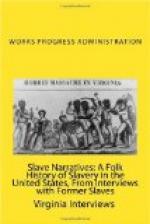“Lord bless your life, Honey! We didn’t live in log cabins, as you call them. There were two slave houses. The one Aggie lived in was two-story, the other one had just one story and they were both weatherboarded like Marse John’s own house. The grown folks slept on beds made with tall oak posts. There were no metal springs then and the beds were corded instead. The straw-stuffed mattress ticks were made with plain and striped material, and pillows were filled with cotton. We children slept on trundle beds, which were pushed up under the big beds in the daytime, and pulled out for us to sleep on at night.
“No Ma’m, there was never any money given to me in slavery time. Remember, Dear, when the yankees came through here, I was only ten years old. Misses Fannie and Ann Crawford were Major Crawford’s daughters, and they kept house for Marse John. That morning in May I was wearing a sleeveless apron, and they (Miss Fannie and Miss Ann) put a bag of gold and silver, and some old greenback Confederate money in my apron and told me to hold on to it. Miss Fannie and Miss Ann, both of them, patted me on the head and said: ‘Now, be a good little girl and don’t move.’ On came the Blue Coats: they went all over the house searching everything with their guns and swords shining and flashing. I was so scared the sweat was running down my face in streams. Bless your life! When they came to the bedroom where I was standing by a bed, holding that money inside my apron, they didn’t even glance at me the second time. Little did they think that little slave girl had the money they were hunting for. After the yankees were gone, I gave it all back to Miss Fannie, and she didn’t give me the first penny. If any of the money was given to my mother she didn’t tell me about it.
“I am going to tell you the truth about what we had to eat, so listen now. It was egg bread, biscuits, peas, potatoes—they they were called ’taters then—artichoke pickles, tea cakes, pies, and good old healthy lye hominy. There was plenty of meat served, but I was not allowed to eat that, as I was never a very strong child. I was a fool about stale bread, such as biscuit, cornbread, and light bread. Mother was a fine cook and her battercakes would just melt in your mouth. Of course, you know we had no stoves in those days and the cooking was done in open fireplaces, in ovens and pots. Oh yes! We had a garden. There was only one on the place and enough was raised in it to feed all of the people living there.
“I don’t remember eating ’possums, rabbits, squirrels and fish until I went to Jackson, Mississippi, with Miss Rosa. There were plenty of those meats in Mississippi and I was then getting old enough and healthy enough to be allowed to eat them.”
At this point, Mary insisted on serving lunch for her visitor, saying that she had lived with white people and knew how to cook. After a polite refusal, the story was continued:




